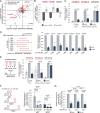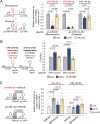ERH promotes primary microRNA processing beyond cluster assistance
- PMID: 40854975
- PMCID: PMC12379101
- DOI: 10.1038/s41467-025-63015-y
ERH promotes primary microRNA processing beyond cluster assistance
Abstract
MicroRNA (miRNA) maturation is initiated by the Microprocessor complex, comprising DROSHA and DGCR8, that processes primary miRNAs (pri-miRNAs). Recent studies have identified ERH and SAFB2 as auxiliary factors that enhance the functionality of the Microprocessor. These factors are required for cluster assistance, where optimal pri-miRNAs facilitate the processing of adjacent suboptimal pri-miRNAs. However, the specific action mechanisms of ERH and SAFB2 have not yet been defined. In this study, we found that ERH broadly enhances the processing of pri-miRNAs regardless of their genomic contexts, affecting both stand-alone and clustered ones. Suboptimal hairpins are affected more prominently by ERH knockdown than efficiently processed hairpins. In contrast, SAFB2 specifically supports the processing of suboptimal pri-miRNA hairpins within clusters. This study reveals the distinct roles of ERH and SAFB2 in cluster assistance and presents a new model, in which SAFB2 facilitates the Microprocessor's transfer between hairpins, while ERH enables the efficient processing of suboptimal pri-miRNAs.
© 2025. The Author(s).
Conflict of interest statement
Competing interests: The authors declare no competing interests.
Figures






Similar articles
-
The structural landscape of Microprocessor-mediated processing of pri-let-7 miRNAs.Mol Cell. 2024 Nov 7;84(21):4175-4190.e6. doi: 10.1016/j.molcel.2024.09.008. Epub 2024 Oct 4. Mol Cell. 2024. PMID: 39368465
-
Interdependence of Pasha and Drosha for localization and function of the Microprocessor in C. elegans.Nat Commun. 2025 Jul 1;16(1):5595. doi: 10.1038/s41467-025-60721-5. Nat Commun. 2025. PMID: 40595566 Free PMC article.
-
ERH facilitates microRNA maturation through the interaction with the N-terminus of DGCR8.Nucleic Acids Res. 2020 Nov 4;48(19):11097-11112. doi: 10.1093/nar/gkaa827. Nucleic Acids Res. 2020. PMID: 33035348 Free PMC article.
-
The Black Book of Psychotropic Dosing and Monitoring.Psychopharmacol Bull. 2024 Jul 8;54(3):8-59. Psychopharmacol Bull. 2024. PMID: 38993656 Free PMC article. Review.
-
Convergent and divergent evolution of microRNA-mediated regulation in metazoans.Biol Rev Camb Philos Soc. 2024 Apr;99(2):525-545. doi: 10.1111/brv.13033. Epub 2023 Nov 21. Biol Rev Camb Philos Soc. 2024. PMID: 37987240 Review.
References
MeSH terms
Substances
LinkOut - more resources
Full Text Sources

